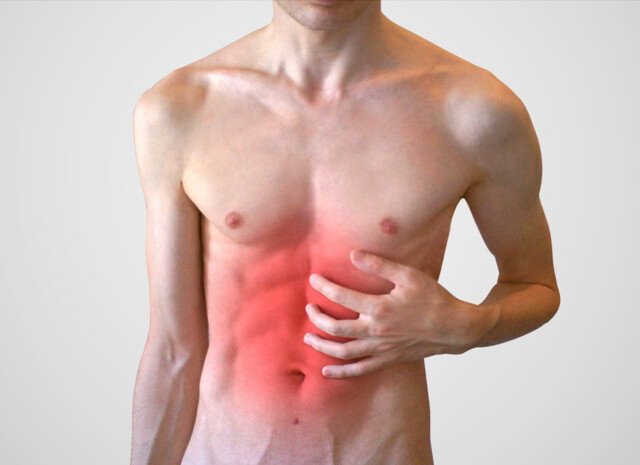
Photo credit:
Gastritis, or inflammation of the stomach lining, is one of the most common digestive disorders worldwide.
Nearly half of the world’s population is exposed to bacteria known to cause gastritis and stomach ulcers. Chronic gastritis can lead to erosion of the digestive tract lining, stomach ulcers, and even stomach cancer.
The stomach is where the food we eat is stored. Stomach cells produce large amounts of hydrochloric acid to begin the digestive process by breaking down large protein molecules into short chains. The stomach lining is adapted to keep the hydrochloric acid from damaging the cells. Stomach cells produce mucin, a carbohydrate-rich protein that protects the stomach lining from the harsh effects of the acid.
Symptoms of gastritis include epigastric pain in the front of the chest just below where the ribs meet the breastbone, nausea, bloating, belching, feeling full during and without eating, loss of appetite, and blood in the vomit and stool. Some people feel better if they have food in their stomach to counteract the effects of stomach acid, while others feel worse.
The most common age for developing gastritis is between 40 and 60, but it can occur at virtually any age. Men tend to be more susceptible than women. Smokers, alcoholics, people with unhealthy diets, and people under a lot of stress are usually more susceptible.
Helicobacter pylori is a rod-shaped bacterium that has developed mechanisms to survive and thrive in the acidic environment of the stomach. The bacterium has large flagella that enable it to attach to the stomach lining. Normally, the stomach can coexist with a small number of bacteria. However, when the stomach’s defense mechanisms are overwhelmed by improper diet, nutrition, or stress, the bacteria can overgrow and cause inflammation of the stomach lining. Chronic inflammation can lead to gastric and duodenal ulcers and even stomach cancer.
Like other bacterial infections, Helicobacter is semi-contagious and can be transmitted through water, food, waste, and close contact. Most people exposed to the bacteria do not develop acute gastroenteritis symptoms. Antibiotics are often prescribed to eradicate Helicobacter.
Diet is very important in preventing and treating gastritis and stomach ulcers. Foods and drinks that are known to worsen gastritis include alcohol, carbonated drinks such as soda, chocolate, fried foods, greasy foods, high-fat foods such as high-fat meats and dairy products, spicy foods, and highly acidic foods and drinks such as coffee, fruit juices, oranges, and tomatoes. Excessive consumption of wheat products has also been found to cause stomach inflammation.
Soft, bland foods are often recommended. Cooked vegetables are preferred over raw vegetables. Non-acid fruits such as bananas and blueberries are well tolerated by many people. Cooked carbohydrates such as mashed potatoes and rice are easier to digest than muesli and multigrain foods. Alkaline green juices rich in vegetables, probiotic yoghurts and non-acid fruits are also helpful. Cabbage is also particularly rich in glutamine, which aids in healing the stomach lining.
H2 blocker drugs are a type of over-the-counter medication that blocks the action of histamine on stomach cells to produce hydrochloric acid. Pepcid (famotidine) and Zantac (ranitidine) are examples of the two most popular H2 stomach acid medications.
PPIs, or proton pump inhibitors, inhibit the production of hydrochloric acid in stomach cells. PPIs are generally considered to be slightly more powerful than H2 blockers. The most common PPIs prescribed include Prevacid (lansoprazole), Nexium (esomeprazole), Prilosec (omeprazole), Pantoloc (pantoprazole), and Pariet (rabeprazole).
Bismuth is a naturally occurring mineral that has antibacterial and gastroprotective properties. Over-the-counter Pepto-Bismol is often recommended for Helicobacter infections and gastritis. It is relatively safe to take for several weeks.
Licorice is one of my favorite herbal remedies and is very good for treating gastritis and stomach problems. Licorice contains compounds that improve the quantity and quality of gastric mucus and increase the strength of the protective layer. Be aware that consuming licorice can lead to high blood pressure and electrolyte imbalances.
DGL or Deglycyrrhizinated Licorice is a type of licorice that has had the offending chemicals removed. DGL can be safely consumed by most people without developing high blood pressure. DGL is best used in conjunction with H2 or PPIs if needed.
Other effective stomach remedies include aloe vera, marshmallow, and slippery elm, which can be taken with or in combination with other medications. Mastic gum is a resin from a Mediterranean shrub that protects the stomach lining and has antibacterial properties.
Probiotic foods and supplements are also often recommended as adjunctive treatments. Fermented foods such as kefir, yogurt, and sauerkraut have been shown to have antibacterial properties and promote healing of the stomach lining.
The information provided in this article does not constitute, nor is it intended to constitute, medical advice. All information and content is for general informational purposes only.
This article was written by or on behalf of an external columnist and does not necessarily reflect the views of Castanet.

